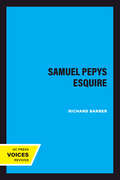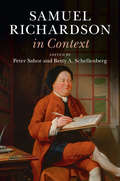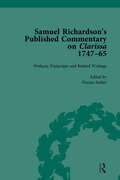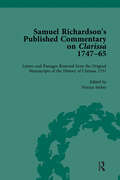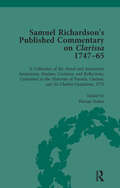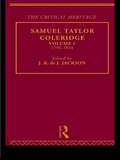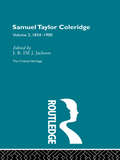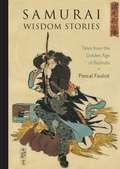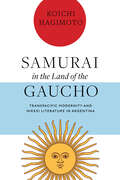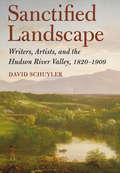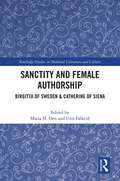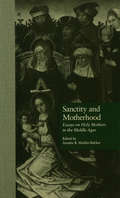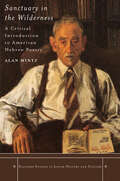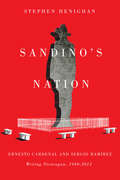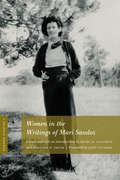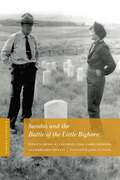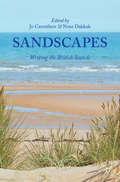- Table View
- List View
Samuel Johnson: The Critical Heritage
by James T. BoultonFirst published in 1995. Routledge is an imprint of Taylor & Francis, an informa company.
Samuel Pepys Esquire
by Richard BarberThis title is part of UC Press's Voices Revived program, which commemorates University of California Press’s mission to seek out and cultivate the brightest minds and give them voice, reach, and impact. Drawing on a backlist dating to 1893, Voices Revived makes high-quality, peer-reviewed scholarship accessible once again using print-on-demand technology. This title was originally published in 1970.This title is part of UC Press's Voices Revived program, which commemorates University of California Press’s mission to seek out and cultivate the brightest minds and give them voice, reach, and impact. Drawing on a backlist dating to 1893, Voices Revived</DIV
Samuel Richardson
by Betty A. SchellenbergSamuel Richardson (1689-1761) was a highly regarded printer and influential novelist when he produced his final work of fiction, The History of Sir Charles Grandison (1753). Like his other novels, it was written in epistolary form, reflecting his lifelong interest in letter writing and the letter as a genre. Covering the period 1750-1754, many of these fully annotated letters are published from manuscript for the first time, or have been restored to their complete original form. Recording Richardson's relationships with leading cultural figures including Samuel Johnson, Colley Cibber and Elizabeth Carter, the volume reveals his support for other authors while struggling to complete his own 'story of a Good Man'. This publishing saga also incorporates Richardson's responses to the Irish piracy of his novel, and his exchanges with anonymous fans, including those who attacked the novel's tolerance for Catholicism and those who pleaded for a sequel.
Samuel Richardson
by David E. Shuttleton John A. Dussinger David E. Shuttleton John A. DussingerSamuel Richardson (1689–1761), among the most important and influential English novelists, was also a prolific letter writer. Beyond its extraordinary range, his correspondence holds special interest as that of a practising epistolary novelist, who thought long and hard about the letter as a form. The Cambridge Edition of the Correspondence of Samuel Richardson is the first complete edition of his letters. The present volume contains his correspondences with Dr George Cheyne and Thomas Edwards, linked not only by their pronounced medical content but also by their generally unguarded character. An early admirer of Richardson's Pamela (1740–41), Cheyne elicits some of the novelist's most significant statements concerning his own literary practice and tastes. Edwards, an astute literary critic as well as notable sonneteer, draws Richardson into expressing some remarkable insights as a close reader of poetry and prose.
Samuel Richardson
by John A. DussingerSamuel Richardson (1689–1761), among the most important and influential English novelists, was also a prolific letter writer. Beyond its extraordinary range, his correspondence holds special interest as that of a practising epistolary novelist, who thought long and hard about the letter as a form. The Cambridge Edition of the Correspondence of Samuel Richardson is the first complete edition of his letters. The present volume contains his correspondences with Dr George Cheyne and Thomas Edwards, linked not only by their pronounced medical content but also by their generally unguarded character. An early admirer of Richardson's Pamela (1740–41), Cheyne elicits some of the novelist's most significant statements concerning his own literary practice and tastes. Edwards, an astute literary critic as well as notable sonneteer, draws Richardson into expressing some remarkable insights as a close reader of poetry and prose.
Samuel Richardson Correspondence with Aaron Hill and the Hill Family
by Christine GerrardSamuel Richardson (1689–1761) was an established master printer when, at the age of 51, he published his first novel, Pamela, and immediately became one of the most influential and admired writers of his time. Not only were all Richardson's novels written in epistolary form: he was also a prolific letter-writer himself. This volume in the first ever full edition of Richardson's correspondence includes his letters to and from Aaron Hill, the poet, dramatist and entrepreneur (1685–1750). Hill was Richardson's earliest literary friend and advisor as he embarked on a new career as a novelist. This correspondence offers fascinating insight into the compositional processes not just of the two Pamela novels, but of Richardson's later novels Clarissa and The History of Sir Charles Grandison. The volume also contains Richardson's correspondence with Hill's three literary daughters, which forms an invaluable chapter in the history of women's writing and literary criticism.
Samuel Richardson and the Art of Letter-Writing
by Louise CurranThis fascinating study examines Samuel Richardson's letters as important works of authorial self-fashioning. It analyses the development of his epistolary style; the links between his own letter-writing practice and that of his fictional protagonists; how his correspondence is highly conscious of the spectrum of publicity; and how he constructed his letter collections to form an epistolary archive for posterity. Looking backwards to earlier epistolary traditions, and forwards, to the emergence of the lives-in-letters mode of biography, the book places Richardson's correspondence in a historical continuum. It explores how the eighteenth century witnesses a transition, from a period in which an author would rarely preserve personal papers to a society in which the personal lives of writers become privileged as markers of authenticity in the expanded print market. It argues that Richardson's letters are shaped by this shifting relationship between correspondence and publicity in the mid-eighteenth century.
Samuel Richardson in Context (Literature in Context)
by Peter Sabor Schellenberg Betty A.Since the publication of his novel Pamela; or Virtue Rewarded in 1740, Samuel Richardson's place in the English literary tradition has been secured. But how can that place best be described? Over the three centuries since embarking on his printing career the 'divine' novelist has been variously understood as moral crusader, advocate for women, pioneer of the realist novel and print innovator. Situating Richardson's work within these social, intellectual and material contexts, this new volume of essays identifies his centrality to the emergence of the novel, the self-help book, and the idea of the professional author, as well as his influence on the development of the modern English language, the capitalist economy, and gendered, medicalized, urban, and national identities. This book enables a fuller understanding and appreciation of Richardson's life, work and legacy, and points the way for future studies of one of English literature's most celebrated novelists.
Samuel Richardson's Published Commentary on Clarissa, 1747-1765 Vol 1
by Margaret Anne Doody Florian StuberThis three-volume set brings together all that Samuel Richardson himself published on the composition, printing and interpretation of "Clarissa". The various short works reveal Richardson's reactions to the concerns and issues raised by contemporary readers.
Samuel Richardson's Published Commentary on Clarissa, 1747-1765 Vol 2
by Margaret Anne Doody Florian StuberThis three-volume set brings together all that Samuel Richardson himself published on the composition, printing and interpretation of "Clarissa". The various short works reveal Richardson's reactions to the concerns and issues raised by contemporary readers.
Samuel Richardson's Published Commentary on Clarissa, 1747-1765 Vol 3
by Margaret Anne Doody Florian StuberThis three-volume set brings together all that Samuel Richardson himself published on the composition, printing and interpretation of "Clarissa". The various short works reveal Richardson's reactions to the concerns and issues raised by contemporary readers.
Samuel Taylor Coleridge: The Critical Heritage Volume 1 1794-1834 (Critical Heritage Ser.)
by J. R. de J. JacksonThe Critical Heritage gathers together a large body of critical sources on major figures in literature. Each volume presents contemporary responses to a writer's work, enabling students and researchers to read for themselves, for example, comments on early performances of Shakespeare's plays, or reactions to the first publication of Jane Austen's novels.The carefully selected sources range from landmark essays in the history of criticism to journalism and contemporary opinion, and little published documentary material such as letters and diaries. Significant pieces of criticism from later periods are also included, in order to demonstrate the fluctuations in an author's reputation.Each volume contains an introduction to the writer's published works, a selected bibliography, and an index of works, authors and subjects.
Samuel Taylor Coleridge: The Critical Heritage Volume 2 1834-1900 (Critical Heritage Ser.)
by J. R. De J. JacksonThe Critical Heritage gathers together a large body of critical sources on major figures in literature. Each volume presents contemporary responses to a writer's work, enabling student and researcher to read the material themselves.
Samurai Wisdom Stories: Tales from the Golden Age of Bushido
by Sherab Chodzin Kohn Pascal FauliotA collection of samurai stories, drawn from traditional sources, of battles, strategy, conflict, and intrigue--featuring some of the greatest warriors and military leaders of the samurai era. Martial artist and samurai scholar Pascal Fauliot has collected and retold twenty-eight wisdom tales of the samurai era. The tales are set in the golden age of bushido and represent the pinnacle of traditional Japanese culture in which aristocratic tastes, feudal virtues, and martial skills come together with the implacable insights of Zen. Some of the stories--like "The Samurai and the Zen Cat"--are iconic; others are obscure. They feature notable figures from samurai history and legend: miltary leaders and strategists such as Oda Nobunaga, Toyotomi Hideyoshi, and Tokugawa Ieyasu; sword masters; ronin; the warrior monk Benkei, and the ninja-samurai Kakei Juzo, among many others. These samurai stories are pithy and engaging, and include tales of battle, strategy, loyalty conflicts, court intrigues, breakthroughs in a warrior's development, and vengeance achieved or foregone. Each tale reveals a gesture or an outcome that represents greater insight or higher virtue.
Samurai in the Land of the Gaucho: Transpacific Modernity and Nikkei Literature in Argentina
by Koichi HagimotoIn the early twentieth century, historical imaginings of Japan contributed to the Argentine vision of &“transpacific modernity." Intellectuals such as Eduardo Wilde and Manuel Domecq García celebrated Japanese customs and traditions as important values that can be integrated into Argentine society. But a new generation of Nikkei or Japanese Argentines is rewriting this conventional narrative in the twenty-first century. Nikkei writers such as Maximiliano Matayoshi and Alejandra Kamiya are challenging the earlier, unapologetic view of Japan based on their own immigrant experiences. Compared to the experience of political persecution against Japanese immigrants in Brazil and Peru, the Japanese in Argentina generally lived under a more agreeable sociopolitical climate. In order to understand the "positive" perception of Japan in Argentine history and literature, Samurai in the Land of the Gaucho turns to the current debate on race in Argentina, particularly as it relates to the discourse of whiteness. One of the central arguments is that Argentina's century-old interest in Japan represents a disguised method of (re)claiming its white, Western identity. Through close readings of diverse genres (travel writing, essay, novel, short story, and film) Samurai in the Land of the Gaucho yields a multi-layered analysis in order to underline the role Japan has played in both defining and defying Argentine modernity from the twentieth century to the present.
Sanctified Landscape: Writers, Artists, and the Hudson River Valley, 1820–1909
by David SchuylerThe Hudson River Valley was the first iconic American landscape. Beginning as early as the 1820s, artists and writers found new ways of thinking about the human relationship with the natural world along the Hudson. Here, amid the most dramatic river and mountain scenery in the eastern United States, Washington Irving and James Fenimore Cooper created a distinctly American literature, grounded in folklore and history, that contributed to the emergence of a sense of place in the valley. Painters, led by Thomas Cole, founded the Hudson River School, widely recognized as the first truly national style of art. As the century advanced and as landscape and history became increasingly intertwined in the national consciousness, an aesthetic identity took shape in the region through literature, art, memory, and folklore-even gardens and domestic architecture. In Sanctified Landscape, David Schuyler recounts this story of America's idealization of the Hudson Valley during the nineteenth and early twentieth centuries. Schuyler's story unfolds during a time of great change in American history. At the very moment when artists and writers were exploring the aesthetic potential of the Hudson Valley, the transportation revolution and the rise of industrial capitalism were transforming the region. The first generation of American tourists traveled from New York City to Cozzens Hotel and the Catskill Mountain House in search of the picturesque. Those who could afford to live some distance from jobs in the city built suburban homes or country estates. Given these momentous changes, it is not surprising that historic preservation emerged in the Hudson Valley-the first building in the United States preserved for its historic significance is Washington's Headquarters in Newburgh. Schuyler also finds the seeds of the modern environmental movement in the transformation of the Hudson Valley landscape. Richly illustrated and compellingly written, Sanctified Landscape makes for rewarding reading. Schuyler expertly ties local history to national developments, revealing the Hudson River Valley was so important to nineteenth-century Americans-and why it is still beloved today.
Sanctity and Female Authorship: Birgitta of Sweden & Catherine of Siena (Routledge Studies in Medieval Religion and Culture)
by Unn Falkeid Maria H. OenBirgitta of Sweden (Birgitta Birgersdotter, 1302/03-1373) and her younger contemporary Catherine of Siena (Caterina Benincasa, 1347-1380) form the most powerful and influential female duo in European history. Both enjoyed saintly reputations in life, while acting as the charismatic leaders of a considerable group of followers consisting of clergy as well as mighty secular men and women. They are also among the very few women of the Trecento to leave a substantial body of written work which was widely disseminated in their original languages and in translations. Copies of Birgitta’s Liber celestis revelacionum (The Heavenly Book of Revelations) and compilations of Catherine's letters (Le lettere), prayers Le orazioni) and her theological work, Il Dialogo della divina Provvidenza (The Dialogue) found their way into monastic, royal, and humanist libraries all over Europe. After their deaths, Birgitta’s and Catherine’s respective groups of supporters sought to have them formally canonized. In both cases, however, their political and theological outspokenness, orally and in text, and their public authority represented obstacles. In this comparative study, leading scholars from different disciplinary backgrounds offer, for the very first time, a comprehensive exploration of the lives and activities of Birgitta and Catherine in tandem. Particular attention is given to their literary works and the complex process of negotiating their sanctity and authorial roles. Above all, what the chapters reveal is the many points of connections between two of the most influential women of the Trecento, and how they were related to one another by their peers and successors.
Sanctity and Motherhood: Essays on Holy Mothers in the Middle Ages (Garland Medieval Casebooks)
by Anneke B. Mulder-BakkerFirst published in 1995. Routledge is an imprint of Taylor & Francis, an informa company.
Sanctity in the North
by Thomas DuboisWith original translations of primary texts and articles by leading researchers in the field, Sanctity in the North gives an introduction to the literary production associated with the cult of the saints in medieval Scandinavia.For more than five hundred years, Nordic clerics and laity venerated a host of saints through liturgical celebrations, written manuscripts, visual arts, and oral traditions. Textual evidence of this widespread and important aspect of medieval spirituality abounds. Written biographies (or vitae), compendia of witnessed miracles, mass propers, homilies, sagas and chronicles, dramatic scripts, hymns, and ballads are among the region's surviving medieval manuscripts and early published books.Sanctity in the North features English translations of texts from Latin or vernacular Nordic languages, in many cases for the first time. The accompanying essays concerning the texts, saints, cults, and history of the period complement the translations and reflect the contributors' own disciplinary groundings in folklore, philology, medieval, and religious studies.
Sanctuary in the Wilderness
by Alan MintzThe effort to create a serious Hebrew literature in the United States in the years around World War I is one of the best kept secrets of American Jewish history. Hebrew had been revived as a modern literary language in nineteenth-century Russia and then taken to Palestine as part of the Zionist revolution. But the overwhelming majority of Jewish emigrants from Eastern Europe settled in America, and a passionate kernel among them believed that Hebrew provided the vehicle for modernizing the Jewish people while maintaining their connection to Zion. These American Hebraists created schools, journals, newspapers, and, most of all, a high literary culture focused on producing poetry. Sanctuary in the Wilderness is a critical introduction to American Hebrew poetry, focusing on a dozen key poets. This secular poetry began with a preoccupation with the situation of the individual in a disenchanted world and then moved outward to engage American vistas and Jewish fate and hope in midcentury. American Hebrew poets hoped to be read in both Palestine and America, but were disappointed on both scores. Several moved to Israel and connected with the vital literary scene there, but most stayed and persisted in the cause of American Hebraism
Sandino's Nation
by Stephen HenighanErnesto Cardenal and Sergio Ramírez are two of the most influential Latin American intellectuals of the late twentieth and early twenty-first centuries. Addressing Nicaragua's struggle for self-definition from divergent ethnic, religious, generational, political, and class backgrounds, they constructed distinct yet compatible visions of national history, anchored in a reappraisal of the early twentieth-century insurgent leader Augusto César Sandino. During the Sandinista Revolution of 1979-90, Cardenal, appointed Nicaragua's minister of culture, became one of the most provocative and internationally recognized figures of liberation theology, while Ramírez, a member of the revolutionary junta, and later elected vice-president of Nicaragua, emerged as an authoritative figure for third world nationalism. But before all else, the two were groundbreaking creative writers. Through a close reading of the works by Nicaragua's best-known and most prolific modern authors, Sandino's Nation studies the construction of Nicaraguan national identity during three distinct periods of the country's recent history - before, during, and after the 1979-90 revolution. Stephen Henighan offers rigorous textual analyses of poems, memoirs, essays, and novels, interwoven with a sharply narrated history of Nicaragua. The only comprehensive study of the careers of Cardenal and Ramírez, Sandino's Nation is essential to understanding transformations to both Nicaragua and the role of the writer in Latin America.
Sandino's Nation: Ernesto Cardenal and Sergio Ramírez Writing Nicaragua, 1940-2012
by Stephen HenighanErnesto Cardenal and Sergio Ramírez are two of the most influential Latin American intellectuals of the late twentieth and early twenty-first centuries. Addressing Nicaragua's struggle for self-definition from divergent ethnic, religious, generational, political, and class backgrounds, they constructed distinct yet compatible visions of national history, anchored in a reappraisal of the early twentieth-century insurgent leader Augusto César Sandino. During the Sandinista Revolution of 1979-90, Cardenal, appointed Nicaragua's minister of culture, became one of the most provocative and internationally recognized figures of liberation theology, while Ramírez, a member of the revolutionary junta, and later elected vice-president of Nicaragua, emerged as an authoritative figure for third world nationalism. But before all else, the two were groundbreaking creative writers. Through a close reading of the works by Nicaragua's best-known and most prolific modern authors, Sandino's Nation studies the construction of Nicaraguan national identity during three distinct periods of the country’s recent history - before, during, and after the 1979-90 revolution. Stephen Henighan offers rigorous textual analyses of poems, memoirs, essays, and novels, interwoven with a sharply narrated history of Nicaragua. The only comprehensive study of the careers of Cardenal and Ramírez, Sandino's Nation is essential to understanding transformations to both Nicaragua and the role of the writer in Latin America.
Sandoz Studies, Volume 1: Women in the Writings of Mari Sandoz (Sandoz Studies)
by John R. Wunder Renée M. Laegreid Shannon D. SmithMari Sandoz, born on Mirage Flats, south of Hay Springs, Nebraska, on May 11, 1896, was the eldest daughter of Swiss immigrants. She experienced firsthand the difficulties and pleasures of the family’s remote plains existence and early on developed a strong desire to write. Her keen eye for detail combined with meticulous research enabled her to become one of the most valued authorities of her time on the history of the plains and the culture of Native Americans.Women in the Writings of Mari Sandoz is the first volume of the Sandoz Studies series, a collection of thematically grouped essays that feature writing by and about Mari Sandoz and her work. When Sandoz wrote about the women she knew and studied, she did not shy away from drawing attention to the sacrifices, hardships, and disappointments they endured to forge a life in the harsh plains environment. But she also wrote about moments of joy, friendship, and—for some—a connection to the land that encouraged them to carry on. The scholarly essays and writings of Sandoz contained in this book help place her work into broader contexts, enriching our understanding of her as an author and as a woman deeply connected to the Sandhills of Nebraska.
Sandoz Studies, Volume 2: Sandoz and the Battle of the Little Bighorn (Sandoz Studies)
by Renée M. Laegreid Leisl Carr Childers Margaret HuettlMari Sandoz&’s The Battle of the Little Bighorn encouraged a change in how Americans viewed this infamous fight. By the mid-twentieth century a towering Custer myth had come to dominate the national psyche as a tale that confirmed national exceptionalism and continental destiny. Sandoz set out to dismantle this myth in an intimate account of the battle told from multiple perspectives. Although the resulting book received mixed reviews at the time, it has emerged through the decades as a visionary reinterpretation of the battle and a literary masterpiece. Decades in the making, The Battle of the Little Bighorn was the renowned western writer&’s last book, published after her death in 1966. The scholarly essays in this collection contextualize Sandoz&’s work in the moment of its writing, situating her treatment of the past within the pivotal moments of her present. The essays address her incorporation of contemporary issues such as the Vietnam War, sensory history, gender study, recentering the Native perspective, environmentalism, and Sandoz&’s personal challenge to completing her last book. The innovative insights into Sandoz&’s perspective of the Battle of the Little Bighorn bring the historical acts involved, and her treatment of the site in which they occurred, into the twenty-first century.
Sandscapes: Writing the British Seaside
by Jo Carruthers Nour DakkakSandscapes: Writing the British Seaside reflects on the unique topography of sand, sandscapes, and the seaside in British culture and beyond. This book brings together creative and critical writings that explore the ways sand speaks to us of holidays and respite, but also of time and mortality, of plenitude and eternity. Drawing together writers from a range of backgrounds, the volume explores the environmental, social, personal, cultural, and political significance of sand and the seaside towns that have built up around it. The contributions take a variety of forms including fiction and nonfiction and cover topics ranging from sand dunes to sand mining, from seaside stories to shoreline architecture, from sand grains to global sand movements, from narratives of the setting up of bed and breakfasts to stories of seaside decline. Often a symbol of aridity, sand is revealed in this book to be an astonishingly fertile site for cultural meaning.

